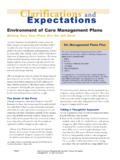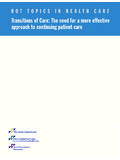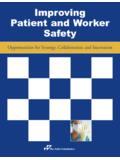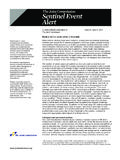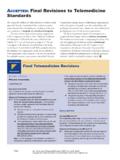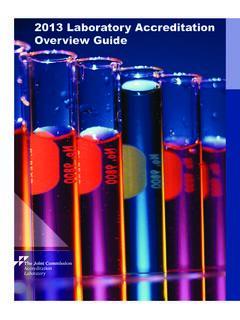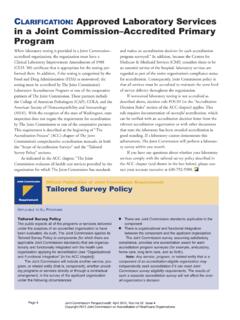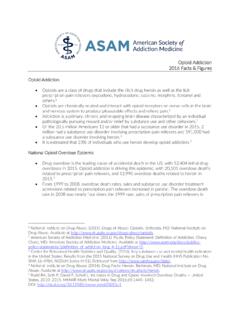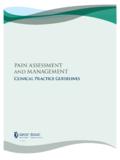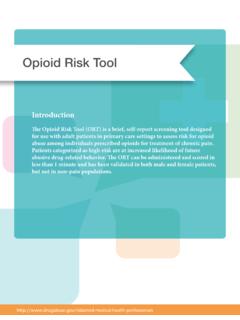Transcription of Joint Commission Enhances Pain Assessment and …
1 Joint Commission Enhances pain Assessment and management Requirements for Accredited HospitalsThe Joint Commission announces the implementation of new and revised pain Assessment and management standards, effective January 1, 2018, for its accredited hospitals. These new and revised requirements were developed through a rigorous research, evaluation, and review early 2016, The Joint Commission began conducting an extensive literature review on contemporary clinical guidelines and best practices for pain Assessment and management , including safe opioid prescribing, in order to identify disparities between its current accreditation requirements and contemporary guidance. Fol-lowing the literature review, staff convened a technical advisory panel of experts to discuss developments in the field of pain Assessment and management . Staff s next step was to conduct learning visits to research leading practices in pain Assessment and management and the safe use of Joint Commission then convened a standards review panel to review draft pain Assessment and management standards.
2 (Standards review panel members, who are nominated from Joint Commission accredited organizations or professional associations, are individuals who can provide a boots-on-the-ground point of view and give insights into the practical application of proposed standards.) Finally, the draft pain Assessment and management standards were released for public comment in January enhanced pain Assessment and management standards include the follow-ing new requirements:l Identifying a leader or leadership team that is responsible for pain management and safe opioid prescribingl Involving patients in developing their treatment plans and setting realistic expectations and measurable goals l Promoting safe opioid use by identify ing high-risk patientsContents1 Joint Commission Enhances pain Assessment and management Requirements for Accredited Hospitals2 In Sight5 Deletions for Distinct Part Units in Critical Access Hospitals5 FSA Tool Temporarily Offline for July 2017 Standards Update6 Protecting Security and Confidentiality on Survey6 Consistent Interpretation7 ClarifiCations and ExpECtations.
3 Understanding Key Changes to the Life Safety Standards11 Revisions to Advanced Stroke Certification Programs Effective January 1, 201812 approvEd: Phase II Revisions to Update Behavioral Health Care Requirements15 New Medication Compounding Chapter for Home Care Manual15 Revisions Continue for Life Safety and Environment of Care Chapters16 Joint Commission Clarifies Four Life Safety Requirements17 New Performance Measures for Advanced Certification in Total Hip and Total Knee Replacement17 Revisions Announced for Comprehensive Stroke Center Measures19 JQPS June Table of ContentsThe Official Newsletter of The Joint CommissionJuly 2017 l Volume 37 l Number 7 on page 3 2017 The Joint Commission Perspectives3l Monitoring high-risk patients l Facilitating clinician access to prescription drug monitoring program databasesl Conducting performance improvement activities focusing on pain Assessment and management to increase safety and quality for patientsThe new and revised requirements shown below (new text is underlined and deleted text has)
4 Strikethrough) will also be posted by the end of June on The Joint Commission website at These revisions will be reflected in the fall 2017 E-dition release for the Compre-hensive Accreditation Manual for Hospitals (as well as the hard copy publications for 2018).Questions may be directed to Trina Crow, RN, MJ, associate project director, Department of Standards and Survey Methods, The Joint Commission , at tcrow@ Joint pJoint Commission Enhances pain Assessment and management Requirements for Accredited Hospitals (continued)Continued from page 1 Official Publication of Joint Commission RequirementsNew and Revised Standards Related to pain Assessment and ManagementApplicAble to HospitAlsEffective January 1, 2018 Leadership (LD)Standard Assessment and pain management , including safe opioid prescribing, is identified as an organizational priority for the of Performance for The hospital has a leader or leadership team that is responsible for pain management and safe opioid prescribing and develops and monitors performance improvement activities.
5 (See also , EP 19)2. The hospital provides nonpharmacologic pain treatment The hospital provides staff and licensed independent practitioners with educational resources and programs to improve pain Assessment , pain management , and the safe use of opioid medications based on the identified needs of its patient population. (See also ,EP 8)4. The hospital provides information to staff and licensed independent practitioners on available services for consultation and referral of patients with complex pain management The hospital identifies opioid treatment programs that can be used for patient The hospital facilitates practitioner and pharmacist access to the Prescription Drug Monitoring Program : This element of performance is applicable in any state that has a Prescription Drug Monitoring Program database, whether querying is voluntary or is mandated by state regulations for all patients prescribed Hospital leadership works with its clinical staff to identify and acquire the equipment needed to monitor patients who are at high risk for adverse outcomes from opioid treatment.
6 (See also , EP 6)Medical Staff (MS)Standard management and coordination of each patient s care, treatment, and services is the responsibility of a practitioner with appropriate of Performance for The hospital educates all licensed independent practitioners on assessing and managing pain . (See also , EP 8). Standard organized medical staff has a leadership role in organiza-tion performance improvement activities to improve quality of care, treatment, and services and patient of Performance for The medical staff is actively involved in pain assess-ment, pain management , and safe opioid prescribing through the following:l Participating in the establishment of protocols and quality metricsl Reviewing performance improvement dataContinued on page 4 The Joint Commission 20174 New and Revised Standards Related to pain Assessment and management (continued) Joint Commission Enhances pain Assessment and management Requirements for Accredited Hospitals (continued)Continued from page 3 Provision of Care, Treatment, and Services (PC)Standard hospital assesses and manages the patient s pain and minimizes the risks associated with of Performance for The hospital conducts a comprehensive pain assess-ment that is consistent with its scope of care, treatment, and services and the patient s condition.
7 (See also , EP 2; , EP 8) 2. 1. D The hospital uses methods has defined criteria to screen, assess, and reassess pain that are consistent with the patient s age, condition, and ability to under-stand. 3. 2. The hospital reassesses and responds to the patient s pain , based on its reassessment criteria screens patients for pain during emergency department visits and at the time of admission. 4. 3. The hospital either treats the patient s pain or refers the patient for : Treatment strategies for pain may include phar-macologic and nonpharmacologic nonpharmacologic, pharmacologic, or a combination of approaches. Strate-gies should reflect a patient-centered approach and consider the patient s current presentation, the health care providers clinical judgment, and the risks and ben-efits associated with the strategies, including potential risk of dependency, addiction, and D The hospital develops a pain treatment plan based on evidence-based practices and the patient s clinical condition, past medical history, and pain management D The hospital involves patients in the pain manage-ment treatment planning process through the following.
8 L Developing realistic expectations and measurable goals that are understood by the patient for the degree, duration, and reduction of painl Discussing the objectives used to evaluate treat-ment progress (for example, relief of pain and improved physical and psychosocial function)l Providing education on pain management , treat-ment options, and safe use of opioid and non-opioid medications when prescribed (See also , EPs 6 8; , EP 6)6. The hospital monitors patients identified as being high risk for adverse outcomes related to opioid treatment. (See also , EP 7)7. D The hospital reassesses and responds to the patient s pain through the following:l Evaluation and documentation of response(s) to pain intervention(s) (See also , EP 7)l Progress toward pain management goals including functional ability (for example, ability to take a deep breath, turn in bed, walk with improved pain control)l Side effects of treatmentl Risk factors for adverse events caused by the treatment8.
9 D The hospital educates the patient and family on discharge plans related to pain management including the following:l pain management plan of carel Side effects of pain management treatmentl Activities of daily living, including the home environ-ment, that might exacerbate pain or reduce effec-tiveness of the pain management plan of care, as well as strategies to address these issuesl Safe use, storage, and disposal of opioids when prescribedPerformance ImprovementStandard hospital collects data to monitor its of Performance for The hospital collects data on pain Assessment and pain management including types of interventions and hospital compiles and analyzes of Performance for The hospital analyzes data collected on pain assess-ment and pain management to identify areas that need change to increase safety and quality for The hospital monitors the use of opioids to determine if they are being used safely (for example, the tracking of adverse events such as respiratory depression, nalox-one use.)
10 And the duration and dose of opioid prescrip-tions). (See also , EP 1)
